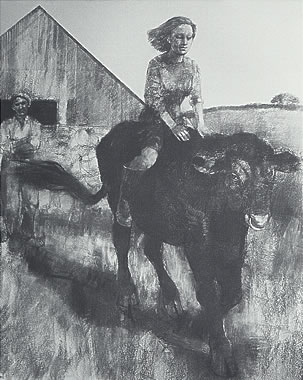5 – 27 September 2001
LONDON – Main Gallery
 From the moment she began exhibiting her beautiful, assured drawings twelve years ago, Bridget Macdonald has attracted the attention of museum curators, collectors of drawings, and people with a love of poetry. In both her paintings and the charcoal drawings, she has tended to focus on the figure in landscape. A retrospective exhibition of Macdonald’s work at Wolverhampton Art Gallery in 1998 revealed an artist of great substance, capable of integrating autobiography and myth to create images that are suffused with memory and quiet mystery.
From the moment she began exhibiting her beautiful, assured drawings twelve years ago, Bridget Macdonald has attracted the attention of museum curators, collectors of drawings, and people with a love of poetry. In both her paintings and the charcoal drawings, she has tended to focus on the figure in landscape. A retrospective exhibition of Macdonald’s work at Wolverhampton Art Gallery in 1998 revealed an artist of great substance, capable of integrating autobiography and myth to create images that are suffused with memory and quiet mystery.
“The idea of the pastoral has been an underlying theme in my work for a long time. Sometimes it has been there in an almost unconscious way, and at other times I have deliberately explored its inherent contradictions. Pastoral has therefore surfaced in different guises over the years – the landscape of the Isle of Wight where my family farmed for generations, the idealised landscapes in Italian Renaissance paintings, figures from classical mythology, (especially Ovid’s Metamorphoses), and even, I realise now, the dark pastoral of Ted Hughes and Sylvia Plath in their Devon retreat, where she wrote most of the bitter poetry which made her famous. I have been intensely drawn to William Blake’s illustrations to Thornton’s translation of Virgil’s Eclogues (actually the only works by Blake which I can respond to wholeheartedly) and in particular an image of a man pulling a roller, which has a strange violence about it.
“The tension between reality and the world of the imagination has been central to pastoral poetry from Virgil onwards. My subject continues to be an exploration of connections between things seen and the art and poetry which have fed my imagination.
“Over the last few years I have taken time out to visit the opera – three summers as an invited artist at Glyndebourne Festival Opera have yielded another rich source of imagery, and I have enjoyed the challenge of responding directly to another art form.”
A catalogue is available with an introduction by Mark Archer.